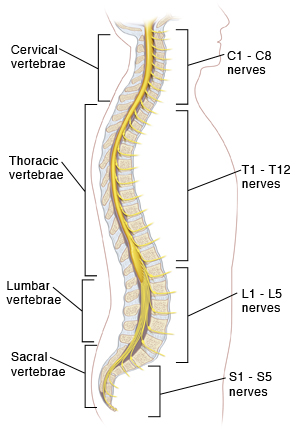Understanding Spinal Cord Injury (SCI)
An SCI can cause reduced feeling and movement in certain parts of the body. Every SCI is different. Every person’s outcome is different as well. This sheet goes over some basic things to know about your level of injury. Your healthcare provider can tell you more about your case.

Spinal cord injury levels
The spine has 33 bones (vertebrae). These bones are grouped into 5 sections:
-
Cervical (C): neck, 7 cervical vertebrae
-
Thoracic (T): upper back, 12 thoracic vertebrae
-
Lumbar (L): lower back, 5 lumbar vertebrae (sometimes 6)
-
Sacral (S): pelvis, 5 fused vertebrae
-
Coccyx: "tailbone," 4 fused vertebrae
The spinal cord runs through the center of the vertebrae from the base of the brain to the lower back. It contains many nerves that control movement and feeling in the body. The nerves exit and enter the spinal cord through spaces between the bones of the spine. There are:
-
8 cervical nerves: C1 through C8
-
12 thoracic nerves: T1 through T12
-
5 lumbar nerves: L1 through L5
-
5 sacral nerves: S1 through S5
-
1 coccygeal nerve
An SCI is named with a letter for the section of the spine and a number for the nerve that was injured. The level of injury determines which parts of the body are affected. The spinal cord ends generally at the level of the L1 or L2 vertebrae. Individual spinal nerves continue below this level to exit at lower vertebral levels.
Grading the severity of your injury
An SCI can be complete. This means there is total loss of movement, bladder control, and feeling below the level of injury. Or an SCI can be incomplete. This means there is some loss of movement, bladder control, or feeling below the level of injury. To assess the severity of your injury, your healthcare provider may use the ASIA scale. With this scale, a grade is given early on. The grade can range from A to E. Grade A means complete paralysis and no sensation, and grade E means normal. The grade is based on the results of various sensory and motor function tests. The ASIA scale grade can improve with treatments. Your healthcare provider can tell you more about the grade of your injury and how often you’ll be tested.
Expected outcomes
Depending on the level and severity of the injury, a person with an SCI will have varying degrees of feeling and movement in their body. Other body functions, such as breathing and bowel and bladder control, may be affected as well. Some people with SCI may be able to do most personal care and daily activities on their own. Others may need more help. This can include help with certain tasks, such as dressing, eating, driving, and moving around.
Everyone is different!
Note that outcomes are different from person to person, even with the same level of injury. Many factors are involved. The grade and severity of your injury may change over time. Your abilities and function may change, too. After a period of adjustment, many people with all levels of SCI report a high quality of life. Work with your healthcare provider and healthcare team to learn what outcomes you might expect with your injury, what treatments and therapies may help you, and what goals to work toward.
Online Medical Reviewer:
Anne Fetterman RN BSN
Online Medical Reviewer:
Luc Jasmin MD
Online Medical Reviewer:
Raymond Kent Turley BSN MSN RN
Date Last Reviewed:
8/1/2022
© 2000-2024 The StayWell Company, LLC. All rights reserved. This information is not intended as a substitute for professional medical care. Always follow your healthcare professional's instructions.